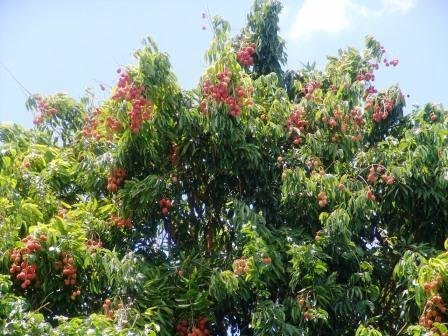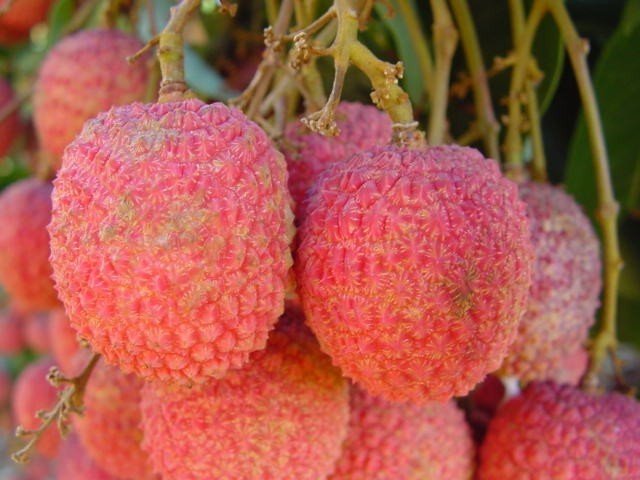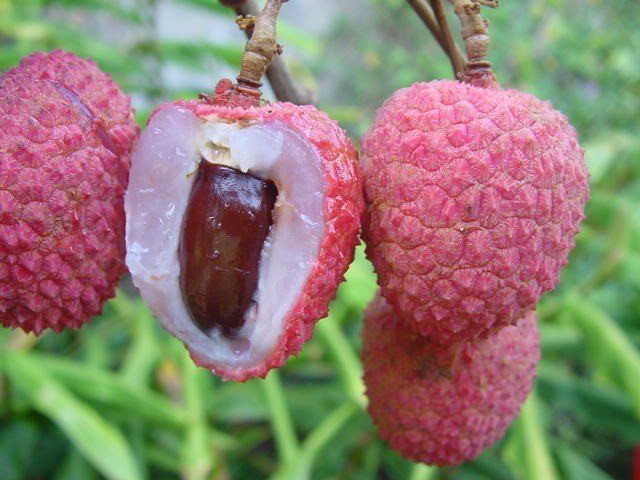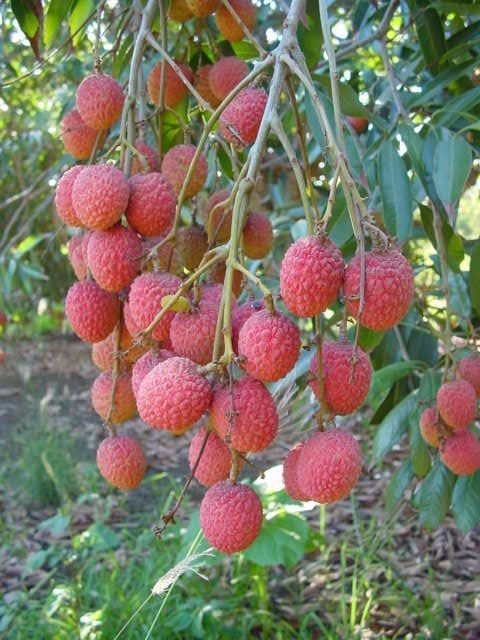





Call it either litchee, litchi, leechee, laichi, lichu, it will always be a very appetizing and delicious fruit which on Reunion Island is synonymous of Christmas and New Year, let us learn more about it.
 Yes, this bright red mouth-watering spherical delicacy maturates during the cyclonic season in the Southern hemisphere, so we can see the first ones at the beginning of December and they can be enjoyed usually until the end of January unless a ferocious cyclone smashes them to the ground. As December also means the appearance of Santa Claus (either the real one or its numerous commercial clones) with his traditional red working clothes as well as a feverish activity of street vendors offering a large array of firecrackers, fire-works, bangers and various detonating devices usually wrapped in red paper, it is like no other fruit could match this colorful frenzy but litchi...Somewhat confidential, almost hiding and red with confusion because of the price they sale for, the first fruits to be offered are soon followed by a real avalanche pouring down from trucks, pick-ups, cars, any available device able to carry them from the field to the greedy buyers.
Yes, this bright red mouth-watering spherical delicacy maturates during the cyclonic season in the Southern hemisphere, so we can see the first ones at the beginning of December and they can be enjoyed usually until the end of January unless a ferocious cyclone smashes them to the ground. As December also means the appearance of Santa Claus (either the real one or its numerous commercial clones) with his traditional red working clothes as well as a feverish activity of street vendors offering a large array of firecrackers, fire-works, bangers and various detonating devices usually wrapped in red paper, it is like no other fruit could match this colorful frenzy but litchi...Somewhat confidential, almost hiding and red with confusion because of the price they sale for, the first fruits to be offered are soon followed by a real avalanche pouring down from trucks, pick-ups, cars, any available device able to carry them from the field to the greedy buyers.
Actually you do not have to be that greedy to eat a kilo or two of those irresistible guys, December also means the hot season, blazing sun and heavy weather which makes you more eager to enjoy juicy fruits rather than hot-dogs or stuffy greasy food! And not only the litchi fruits are full of sweet juice but they also contain lots of C vitamin (as much as in lemons), B vitamin, and various minerals amongst which potassium. The only draw-back would be for people suffering from diabetes as the pulp has high glucose content. As we have ample supplies during the season we enjoy the fresh fruit while it lasts and then wait for the next season to come but the fruits can be transformed into juice, dried or canned into syrup. Although many people in Europe and Northern America know the fruit only through the canned desserts supplied in many Chinese restaurants it is almost impossible to eat those when you have tasted the fresh ones a few hours after harvest!
Now, let us see where this marvel comes from. The readers familiar with botanical names will of course know from the species epithet chinensis (sometimes written sinensis) that it comes from...China of course. More precisely it originates from the lowlands of Southern China in the provinces of Kwangtung and Fukien where it has been recorded to be grown since 2000 BC. From there it slowly spread through Southern Asia around the years 1600, reaching India a century later and Australia in the 1800's. It was introduced in Hawaii in 1873, in Florida in 1883 from which it was brought to California in 1897. It is nowadays grown in every tropical country. Back to botany; this is the only species within the Litchi genus belonging to the Sapindaceae family which hosts some 147 other genera amongst which are the Indian horse-chestnut, the soapberry and the longan. There are of course many varieties which differentiate each other by the size of the tree, the size and color of the fruits, the fruiting season, the taste of the flesh, some are better known like ‘Kwai Mi', ‘Bengale', ‘Haak Ip'.
 The tree itself can become pretty massive with a rounded habit and still be alive at 100 years old, reaching a height of 12 meters (40 feet), with a short soon branched trunk covered by a grey bark. The leaves are shiny dark green, elongated, rather brittle. Flowers are quite inconspicuous, yellowish green and without petals. Fruits come in clusters at the end of the branches; they can be round or oval in shape, covered with a leathery rind bright red to pale pink. This skin breaks easily to uncover the white aril (the edible part or flesh) surrounding the stone or seed. Some cultivars have been developed which produce a very small seed, hence leaving more room for the flesh.
The tree itself can become pretty massive with a rounded habit and still be alive at 100 years old, reaching a height of 12 meters (40 feet), with a short soon branched trunk covered by a grey bark. The leaves are shiny dark green, elongated, rather brittle. Flowers are quite inconspicuous, yellowish green and without petals. Fruits come in clusters at the end of the branches; they can be round or oval in shape, covered with a leathery rind bright red to pale pink. This skin breaks easily to uncover the white aril (the edible part or flesh) surrounding the stone or seed. Some cultivars have been developed which produce a very small seed, hence leaving more room for the flesh.
Propagation is done by air layering or grafting which should be preferred as the seedling on which it is grafted will give a better and stronger root system than what would be produced by an air layering. Growing a lichee tree from a seedling would be a most deceiving thing as it would not produce fruits before 10 to 20 years and those could be highly deceptive...Now that we have our small tree we will need the adequate place to grow. Regarding climate what we want is a tropical weather just like in...Southern China of course! The plant requires a hot humid climate with a dry and colder period of time in order to trigger flowering. It will enjoy well drained rich soil, able to keep some moisture but not to stay soaked which would soon kill the tree. Full sun is essential though young trees will benefit from some protection. Being a tropical species it will not stand cold spells for long even if a well established tree may tolerate light freezes for short periods. Irrigation will be required if you are in a dry area, especially in time of active growth and fruit forming. When fruits are fully ripe they are to be harvested by breaking the end of branches thus picking them with some leaves, the breaking (or cutting) of the end shoots will act as stress and allow a better fruiting for next season. Although much better if eaten right away they can be kept in the fridge for several weeks while they will start drying and deteriorate after three or four days at room temperature.
Hope I have you salivating and make you in desperate need of a bag of crisp fresh juicy sweet litchi by now!
Copyright © www.100flowers.win Botanic Garden All Rights Reserved